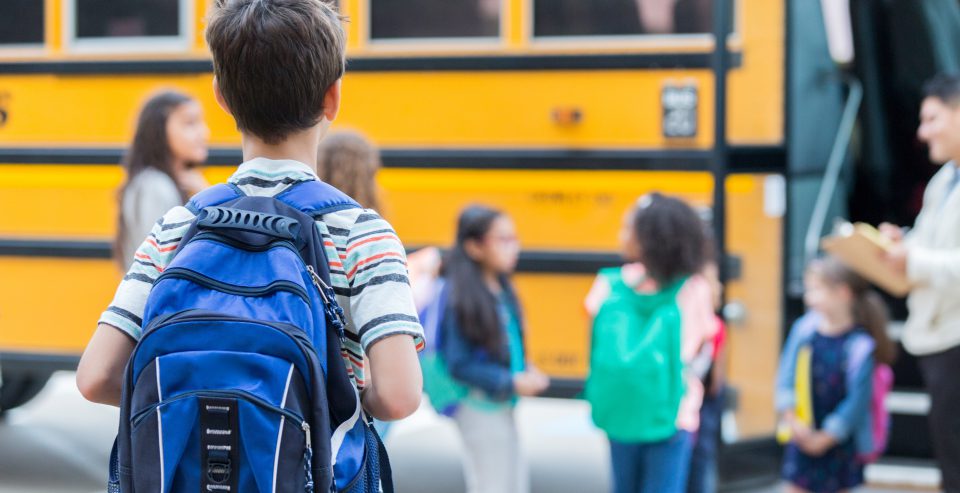The beginning of the school year is a busy time for parents and children. Along with new clothes, fresh school supplies, new teachers, schedules, and books, back-to-school season can bring health changes. Children are susceptible to many common illnesses associated with close in classrooms.
Learn more about the services at UPMC Children’s Hospital of Pittsburgh.
Never Miss a Beat!
Subscribe to Our HealthBeat Newsletter!
Thank you for subscribing!
You can now select the specific newsletters you'd like to receive.
You are already subscribed.
Subscribe to more newsletters in our email preference center.
Sorry, an error occurred. Please try again later.
Get Healthy Tips Sent to Your Phone!
Head Lice and Close Contact
Lice are tiny insects that live on human hair and feed on small amounts of blood. When an infestation occurs, lice attach their eggs to the base of your hair shaft. People spread head lice via contact with one another. Head lice do not spread illness, so they’re not usually dangerous.
Symptoms of head lice
- Tickling feeling on your head
- Sores from scratching
- Red bumps on your head
- Difficulty sleeping
- Irritability
How to prevent head lice
Instruct your child to avoid head-to-head contact with other kids, such as when they’re taking selfies. You should not allow your child to share brushes, combs, hair ribbons, or clothing. Head lice are only passed on through direct contact; they can’t jump or fly.
Head lice treatment
Before beginning any treatment for head lice, check with your pediatrician. Doctors often prescribe medication followed by a specific combing method used 8-12 hours after your child has been treated for lice.
When combing your child’s hair, be sure to check for dead lice. If you don’t find any, the medication may not be working and you should contact the pediatrician.
Pink Eye in School-Age Kids
Pink eye is a highly contagious and common eye infection that often occurs in children. The four main causes of pink eye are viruses, bacteria, allergens, and irritants such as chlorine.
Common pink eye symptoms
The most common symptoms of pink eye are:
- Redness or swelling of the white part of your eye
- Itching, burning, or irritation
- Increased tear production
- Crusting of your eyelashes or eyelids
How to prevent pink eye
Because pink eye is so contagious, the best way to prevent your child from developing it is to encourage them to wash their hands with warm water and soap as often as possible. Your child also should avoid rubbing or touching their eyes throughout the school day.
Treating pink eye
If your child develops pink eye, call your pediatrician to discuss treatment options. Cool compresses can provide relief from symptoms. To avoid spreading pink eye to other members of the household, avoid sharing clothing, blankets, and pillowcases, and wash those items frequently.
Chickenpox in Young Children
Chickenpox is a childhood virus that covers the body in itchy, red spots. Not as common today, chickenpox still appears in school-age children who have not been vaccinated against it. In addition to its telltale red splotches, chickenpox also can cause fever and body aches.
Symptoms of chickenpox
The most common symptoms of chickenpox are:
-
- Itchy, red blisters and rash that spread all over your body. The rash may have an appearance often described as “dew drops on a rose petal”
- Fever
- Sore throat
- Headache
- Loss of appetite
Chickenpox prevention
The best way to prevent children from getting chickenpox is to have them vaccinated. Most people who get the vaccine never develop the condition. Though mainly associated with young children, chickenpox can occur in teens and adults.
Treatment for chickenpox
While there are no medications to treat chickenpox, there are helpful remedies including:
-
-
- Calamine lotion and oatmeal baths to help reduce itching
- Cocoa butter and vitamin E oil to prevent scarring
- Acetaminophen for fever and headaches
-
The Common Cold in the Classroom
The common cold is one of the most contagious illnesses spread in schools. Colds are airborne, but also can be spread through person-to-person contact. In a classroom environment, catching a cold at some point during the school year is highly likely.
Common cold symptoms
Symptoms to look out for in children are:
-
-
-
- Runny or stuffy nose
- Coughing
- Sneezing
- Sore throat
- Fever
- Muscle aches
- Loss of appetite
-
-
Preventing the common cold
To avoid catching a cold, children should wash their hands often and avoid anyone with cold symptoms.
Treating the common cold
There is no cure for the common cold. As the virus runs its course, be sure that your child gets plenty of rest and drinks lots of fluids. If a child develops a secondary infection, such as an ear infection, the doctor may prescribe antibiotics.
About Pediatrics
From nutrition to illnesses, from athletics to school, children will face many challenges growing up. Parents often will make important health care decisions for them. We hope to help guide both of you in that journey. UPMC Children’s Hospital of Pittsburgh is a national leader in pediatric care, ranking consistently on U.S. News & World Report’s Best Children’s Hospitals Honor Roll. We provide expert treatment for pediatric diseases, along well-child visits, urgent care, and more. With locations across Pennsylvania, Maryland, and West Virginia, you can find world-class care close to home. We also work closely with UPMC Magee-Womens Hospital, a national leader in care for newborns and their mothers. Our goal is to provide the best care for your children, from birth to adulthood and beyond. Visit our website to find a doctor near you.
